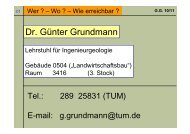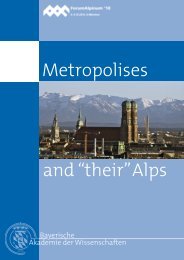The 1806 Goldau landslide event—analysis of a large rock slide
The 1806 Goldau landslide event—analysis of a large rock slide
The 1806 Goldau landslide event—analysis of a large rock slide
Create successful ePaper yourself
Turn your PDF publications into a flip-book with our unique Google optimized e-Paper software.
Figure 4. Longitudinal section through the sliding plane <strong>of</strong> the <strong>Goldau</strong> <strong>rock</strong><strong>slide</strong> (Berner 2004,<br />
modified).<br />
Figure 5. Detailed longitudinal section along the eastern scarp <strong>of</strong> the <strong>rock</strong> <strong>slide</strong> (from Figure 4; Berner<br />
2004, modified) with rupture surface. <strong>The</strong>re is a discrete transition between marl and conglomerate.<br />
<strong>The</strong> bedding planes <strong>of</strong> the conglomerates and marlstones control the rupture surfaces <strong>of</strong><br />
the main <strong>slide</strong>. Near the main scarp, the sliding planes run through the marl layers following<br />
the dipping <strong>of</strong> the strata (Figure 5 left side; Figure 6 left picture). In the middle part, there<br />
is a transition between the marlstones and conglomerates (Figure 6 right picture), where<br />
the rupture surface still follows the bedding, but cuts through conglomerates in a staircaseshaped<br />
way using steep joints. Where joints are not available, the conglomerates fail in a<br />
brittle manor forming arch-like fractures, intersecting deeper and deeper into the thick conglomerate<br />
beds (Figure 7).<br />
As a result <strong>of</strong> the detailed mapping, the rupture surface has developed in the conglomerates<br />
over a <strong>large</strong> distance in a brittle manor. If available, <strong>of</strong> course the marlstones are the<br />
easier way to fail. <strong>The</strong>refore one has to deal with the failure mechanism in the marlstones as<br />
well as the brittle failure in the conglomerates.<br />
2.3 Sliding planes on the Rossberg<br />
Besides the sliding planes <strong>of</strong> the <strong>1806</strong> <strong>rock</strong> <strong>slide</strong> in the upper area, numerous other planes<br />
are visible at the Rossberg slope (Figure 8). Particularly there is a <strong>large</strong> sliding plane covered<br />
with forest and pasture (Plane 1 in Figure 8) visible below the stepped and exposed <strong>rock</strong>-like<br />
surface <strong>of</strong> the <strong>1806</strong> plane (Plane 3). <strong>The</strong> volume <strong>of</strong> the debris <strong>of</strong> this presumably prehistoric<br />
<strong>land<strong>slide</strong></strong> <strong>of</strong> Oberarth can be estimated with 100 million m3 and is supposed to build<br />
3696















